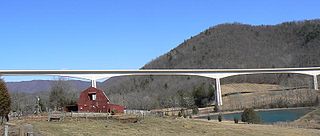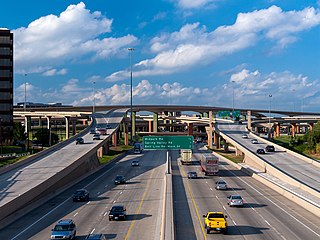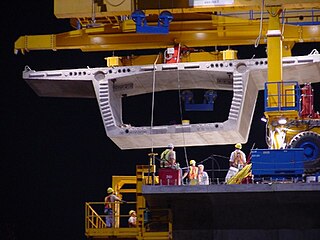
U.S. Highway 181 is a south–north U.S. Highway located entirely in the state of Texas. Both termini are at Interstate 37, the road that it mainly parallels to the east. US 181 begins in Corpus Christi, Texas at mile marker 0 to the south, through south-central Texas to just south of San Antonio to the north, for a total length of 137 miles (220 km).

The Seven Mile Bridge is a bridge in the Florida Keys, in Monroe County, Florida, United States. It connects Knight's Key in the Middle Keys to Little Duck Key in the Lower Keys. Among the longest bridges in existence when it was built, it is part of the Overseas Highway in the Keys, which is part of the 2,369-mile (3,813 km) U.S. Route 1.

A box girder bridge, or box section bridge, is a bridge in which the main beams comprise girders in the shape of a hollow box. The box girder normally comprises prestressed concrete, structural steel, or a composite of steel and reinforced concrete. The box is typically rectangular or trapezoidal in cross-section. Box girder bridges are commonly used for highway flyovers and for modern elevated structures of light rail transport. Although the box girder bridge is normally a form of beam bridge, box girders may also be used on cable-stayed and other bridges.

Bangabandhu Bridge, also known as the Jamuna Multi-purpose Bridge is a bridge opened in Bangladesh in June 1998. It connects Bhuapur on the Jamuna River's east bank to Sirajganj on its west bank. It was the 11th longest bridge in the world when constructed in 1998 and at present is the 6th longest bridge in South Asia. The Jamuna River, which it spans, is one of the three major rivers of Bangladesh, and is fifth largest in the world in discharge volume.

The Wilson Creek Bridge is the second tallest bridge in Virginia at 175 feet (53 m) tall, the tallest being the US-460 Corridor Q bridge over Grassy Creek and Virginia State Route 610 between Pike County and Buchanan County at 225 feet (69 m) tall.

The High Five Interchange is one of the first five-level stack interchanges built in Dallas, Texas. Located at the junction of the Lyndon B. Johnson Freeway and the Central Expressway, it replaces an antiquated combination interchange constructed in the 1960s.

A segmental bridge is a bridge built in short sections, i.e., one piece at a time, as opposed to traditional methods that build a bridge in very large sections. The bridge is made of concrete that is either cast-in-place or precast concrete.

Sam Houston Tollway Ship Channel Bridge is a span in Harris County, Texas. It was acquired from the then–Texas Turnpike Authority (TTA) on May 5, 1994, and is now a part of the Harris County Toll Road Authority system. The bridge opened to traffic in May 1982 and carries four lanes of the Sam Houston Tollway over the Houston Ship Channel with a clearance of 175 feet (53 m).

An extradosed bridge employs a structure that combines the main elements of both a prestressed box girder bridge and a cable-stayed bridge. The name comes from the word extrados, the exterior or upper curve of an arch, and refers to how the "stay cables" on an extradosed bridge are not considered as such in the design, but are instead treated as external prestressing tendons deviating upward from the deck. In this concept, they remain part of the main bridge superstructure.

The I-90 Mississippi River Bridge, or the Dresbach Bridge, consists of a pair of parallel bridges that traverse the Mississippi River, connecting the La Crosse, Wisconsin area to Dresbach in rural Winona County, Minnesota. The current bridge was fully opened to traffic in October 2016, replacing a previous 1967 plate girder bridge. It is part of the Interstate 90 route. There is another automobile crossing a few miles south of this bridge; the Mississippi River Bridge, a combination of two bridges, and the La Crosse West Channel Bridge, connecting La Crescent, Minnesota and La Crosse, Wisconsin.

The Natchez Trace Parkway Bridge is a concrete double arch bridge located in Williamson County, Tennessee, 8.7 mi (14.0 km) from the northern terminus of the Natchez Trace Parkway. It is 1,572 ft (479 m) long and carries the two-lane Natchez Trace Parkway 145 ft (44 m) over State Route 96 and a heavily wooded valley.
Eugene C. Figg was an American structural engineer who made numerous contributions to the field of structural engineering, especially in the design of the cable-stayed bridge and the use of the segmental concrete construction method.

The James B. Edwards Bridge, also referred to as the Wando River Bridge, is a pair of pre-cast post-tensioned concrete box girder bridges that span the Wando River between Mount Pleasant and Daniel Island on Interstate 526 (I-526) in South Carolina.

The I-35W Saint Anthony Falls Bridge crosses the Mississippi River one-half mile downstream from the Saint Anthony Falls in Minneapolis, Minnesota in the U.S., carrying north–south traffic on Interstate 35W. The ten-lane bridge replaced the I-35W Mississippi River bridge, which collapsed on August 1, 2007. It was planned and is maintained by the Minnesota Department of Transportation (MnDOT). The planning, design, and construction processes were completed more quickly than normal because Interstate 35W is a critical artery for commuters and truck freight. The bridge opened September 18, 2008, well ahead of the original goal of December 24.

The Corpus Christi Harbor Bridge is a through arch bridge in Corpus Christi, Texas, that carries six lanes of U.S. Route 181 (US 181) and Texas State Highway 35 (SH 35) from downtown Corpus Christi to Rincon Point, known to locals as North Beach. The bridge crosses the Corpus Christi Ship Channel and handles nearly 26,000 vehicles daily. A new bridge called the New Harbor Bridge is under construction. When complete, it will allow larger ships to pass beneath, permit safer pedestrian transit, and reconfigure the highway interchange system in the surrounding community.

Interstate 69 (I-69) is an Interstate Highway that is in the process of being built in the U.S. state of Texas. It is part of a longer I-69 extension known as the NAFTA superhighway, that, when completed, will connect Canada to Mexico. In Texas, it will connect Tenaha and the Louisiana segment of the route through the eastern part of the state and along the Texas Gulf Coast to Victoria, where it will split into three branches: I-69E to Brownsville, I-69C to Pharr, and I-69W to Laredo. The first segment of I-69 in Texas was opened in 2011 near Corpus Christi. The American Association of State Highway and Transportation Officials (AASHTO) approved an additional 58 miles (93 km) of U.S. Highway 77 (US 77) from Brownsville to the Willacy–Kenedy county line for designation as I-69, which was to be signed as I-69E upon concurrence from the Federal Highway Administration (FHWA). FHWA approval for this segment was announced on May 29, 2013. By March 2015, a 74.9-mile (120.5 km) section of US 59 had been completed and designated as I-69 through Greater Houston. As of 2024, short segments near the southern terminuses of the three branch routes have also all been completed. These branches are planned to be connected to the rest of the Interstate Highway System.
The John F. Kennedy Memorial Causeway is a paved highway located in Corpus Christi, Texas. The causeway crosses the Laguna Madre and connects North Padre Island with Flour Bluff on the Texas mainland.

Interstate 69E (I-69E) is a north–south Interstate Highway running through South Texas. Once complete, the freeway will begin in Brownsville and head northward before terminating near Victoria as both I-69W and I-69E merge into I-69 toward Houston. For its entire length, I-69E runs concurrently with U.S. Highway 77 (US 77). The route currently exists in two segments: a 56.894-mile (91.562 km) segment from its southern terminus in Brownsville to the Willacy–Kenedy county line and a shorter 7.672-mile (12.347 km) segment south of Corpus Christi. The route has one auxiliary Interstate route, I-169 in Brownsville.

A launching gantry is a special-purpose mobile gantry crane used in bridge construction, specifically segmental bridges that use precast box girder bridge segments or precast girders in highway and high-speed rail bridge construction projects. The launching gantry is used to lift and support bridge segments or girders as they are placed while being supported by the bridge piers instead of the ground.
The Sagadahoc Bridge is a four-lane concrete segmental box girder bridge between the City of Bath and the town of Woolwich, Maine, carrying U.S. Route 1 (US 1) over the Kennebec River. It was completed in 2000 to replace the two-lane road portion of the adjoining 1927 Carlton Bridge, which remains in use as a rail bridge. It is 2,972-foot-long (906 m) and features the longest precast concrete segmental span in North America at 420 feet (130 m). It is also notable for being the first design/build project undertaken by the Maine Department of Transportation. The bridge cost $46.6 million, and is the last downstream road crossing of the Kennebec.



















